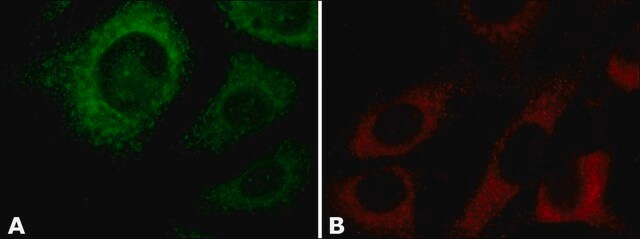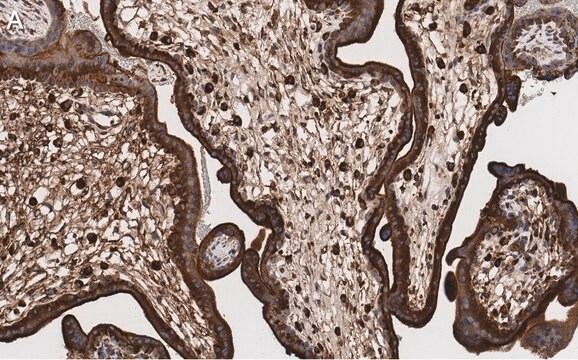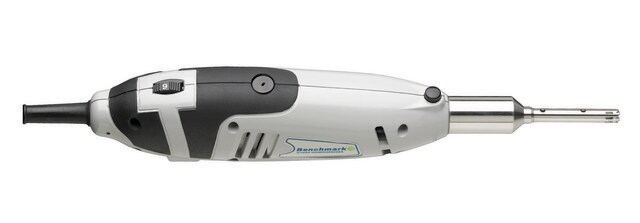ZRB1694
Anti-Histone H2B Antibody, clone 1L5 ZooMAb® Rabbit Monoclonal

recombinant, expressed in HEK 293 cells
Sinónimos:
H2B, H2B type 12
About This Item
Productos recomendados
origen biológico
rabbit
Nivel de calidad
recombinante
expressed in HEK 293 cells
conjugado
unconjugated
forma del anticuerpo
purified antibody
tipo de anticuerpo
primary antibodies
clon
1L5, recombinant monoclonal
descripción
recombinant, expressed in HEK 293 cells
Línea del producto
ZooMAb® learn more
formulario
lyophilized
mol peso
calculated mol wt 13.91 kDa
observed mol wt ~15 kDa
purificado por
using Protein A
reactividad de especies
rat, human
reactividad de especies (predicha por homología)
mouse, monkey, canine, feline, bovine, porcine
envase
antibody small pack of 25 μL
características de los productos alternativos más sostenibles
Waste Prevention
Designing Safer Chemicals
Design for Energy Efficiency
Learn more about the Principles of Green Chemistry.
validación mejorada
recombinant expression
Learn more about Antibody Enhanced Validation
sustainability
Greener Alternative Product
técnicas
affinity binding assay: suitable
immunohistochemistry: suitable
western blot: suitable
isotipo
IgG
secuencia del epítopo
N-terminal
Nº de acceso Protein ID
Nº de acceso UniProt
categoría alternativa más sostenible
, Aligned
Condiciones de envío
ambient
temp. de almacenamiento
2-8°C
modificación del objetivo postraduccional
unmodified
Información sobre el gen
human ... H2BU1(128312)
Descripción general
Especificidad
Inmunógeno
Aplicación
Evaluated by Western Blotting in A431 cell lysate.
Western Blotting Analysis: A 1:10,000 dilution of this antibody detected Histone H2B in A431 cell lysate.
Tested applications
Western Blotting Analysis: A 1:1,000 dilution from a representative lot detected Histone H2B in PC12 and L6 cell lysate and in HeLa cell acid extract.
Immunohistochemistry (Paraffin) Analysis: A 1:100 dilution from a representative lot detected Histone H2B in human cerebral cortex tissue sections.
Affinity Binding Assay: A representative lot of this antibody bound Histone H2B peptide with a KD of 4.7 x 10-7 in an affinity binding assay.
Note: Actual optimal working dilutions must be determined by end user as specimens, and experimental conditions may vary with the end user
Evaluated by Western Blotting in A431 cell lysate.
Western Blotting Analysis: A 1:10,000 dilution of this antibody detected Histone H2B in A431 cell lysate.
Descripción de destino
Forma física
Reconstitución
Almacenamiento y estabilidad
Información legal
Cláusula de descargo de responsabilidad
¿No encuentra el producto adecuado?
Pruebe nuestro Herramienta de selección de productos.
Código de clase de almacenamiento
11 - Combustible Solids
Clase de riesgo para el agua (WGK)
WGK 1
Punto de inflamabilidad (°F)
Not applicable
Punto de inflamabilidad (°C)
Not applicable
Certificados de análisis (COA)
Busque Certificados de análisis (COA) introduciendo el número de lote del producto. Los números de lote se encuentran en la etiqueta del producto después de las palabras «Lot» o «Batch»
¿Ya tiene este producto?
Encuentre la documentación para los productos que ha comprado recientemente en la Biblioteca de documentos.
Nuestro equipo de científicos tiene experiencia en todas las áreas de investigación: Ciencias de la vida, Ciencia de los materiales, Síntesis química, Cromatografía, Analítica y muchas otras.
Póngase en contacto con el Servicio técnico








